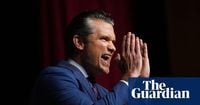On September 30, 2025, the usually serene expanse of Marine Corps Base Quantico in Virginia buzzed with an intensity not seen in years. Hundreds of the United States’ most senior military leaders—generals and admirals from as far afield as Europe, South Korea, and the Middle East—were summoned on short notice for a gathering whose purpose was shrouded in secrecy. The event, held under tight security at the sprawling 55,000-acre installation, would soon become a defining moment for the U.S. military’s future direction, as Defense Secretary Pete Hegseth and President Donald Trump delivered back-to-back speeches that left little doubt about their vision for America’s armed forces.
Opening the summit, Secretary Hegseth wasted no time in setting a combative tone. Standing before a sea of uniforms, he declared, “Standards must be uniform, gender neutral, and high,” and announced that all combatants would henceforth be required to meet the “highest male standard” in physical fitness tests. He acknowledged, with no hint of apology, that this change could exclude some women from serving in combat roles. According to CNN, Hegseth’s remarks signaled a sharp pivot away from previous efforts to broaden inclusivity within the ranks.
But physical standards were just the beginning. Hegseth’s address, as reported by Reuters, was a sweeping indictment of what he called “decades of decay” within the Pentagon, blaming “foolish and reckless political leaders” for steering the military off course and turning it into what he derisively labeled the “Woke Department.” He didn’t mince words, telling the assembled officers, “If the words I’m speaking today are making your hearts sink, then you should do the honorable thing and resign.” He then added, “I know the overwhelming majority of you feel the opposite. These words make your hearts full.”
Throughout his speech, Hegseth promised an end to diversity, equity, and inclusion (DEI) programs, which he claimed had contributed to a “risk-averse” officer corps distracted by “climate change distractions” and “woke garbage.” He also took aim at military grooming standards, vowing an end to “unprofessional appearances” and beard exemptions. “The era of unprofessional appearance is over. No more beardos,” he declared, a line that drew no visible reaction from the audience, who mostly sat in silence, some scribbling notes in field notebooks, as described by BBC.
In a particularly pointed moment, Hegseth criticized the look of overweight military leaders, saying, “It’s completely unacceptable to see fat generals and admirals in the halls of the Pentagon.” He went on to defend his firing of senior commanders—including the top U.S. general and the Navy’s top admiral—insisting he had followed his gut to remove those unwilling to shift away from the policies of previous administrations. “More leadership changes will be made, I’m certain,” he warned.
Hegseth’s overhaul wasn’t limited to personnel and physical standards. He promised sweeping changes to how discrimination complaints and accusations of wrongdoing are handled, criticizing the current system for leaving top brass “walking on egg shells.” Anonymous complaints procedures would be scrapped, and investigations would be restructured to, in his words, restore a “warrior ethos” at every level.
As the Defense Secretary left the stage, the sound of hundreds of boots snapping to attention echoed through the auditorium—a rare, symbolic moment of unity, or perhaps simply tradition. The silence was quickly broken by President Trump, who took the stage with his trademark bravado. “I’ve never walked into a room so silent before,” he joked, before launching into a wide-ranging address that touched on everything from U.S. nuclear submarines to his administration’s record.
Trump’s message was clear: the military’s new direction had his full backing. “Together, we’re reawakening the warrior spirit. And this is a spirit that won and built this nation,” he proclaimed, echoing Hegseth’s rhetoric. He boasted of having “settled” seven wars during his presidency and expressed hope for an eighth, contingent on Hamas accepting his latest proposal for Gaza. According to NBC News, Trump described the gathering as an exercise in generating “esprit de corps,” framing it as an opportunity to galvanize the nation’s top military leaders for the challenges ahead.
But the president also issued a stern warning, one that underscored the high stakes of the day. “If you don’t like what I’m saying, you can leave the room—of course, there goes your rank, there goes your future,” he said, half in jest, half in earnest. He made it clear that military promotions and careers would be based on merit, not “politically correct” considerations. “I am with you. I support you, and as president, I have your backs 100%,” Trump added, seeking to reassure the audience even as he demanded their loyalty.
Observers both inside and outside the military took note of the event’s extraordinary nature. Giuseppe Cavo Dragone, chair of the NATO Military Committee, told the Associated Press, “As far as my 49 years of service, I’ve never seen that before.” Mark Cancian, a senior adviser at the Center for Strategic and International Studies, expressed puzzlement to Reuters: “It is mystifying why this was not done virtually so that senior officers don’t have to spend a lot of time travelling.”
Behind the scenes, speculation swirled about the true purpose of the summit. While Vice President JD Vance downplayed the significance, saying it was “not particularly unusual” for generals to meet the defense secretary in person, the sheer scale and secrecy of the gathering suggested otherwise. The BBC noted that no official reason was publicly provided for the meeting, fueling rumors and debate across Washington and beyond.
As the day drew to a close, one thing was clear: the U.S. military was being steered onto a new, unambiguous path, one defined by stricter standards, a return to traditional “warrior” values, and a decisive rejection of recent diversity initiatives. Whether these changes will strengthen the military or sow further division remains to be seen, but the message from Quantico was unmistakable—change, for better or worse, is here.
For the generals and admirals who sat in that silent auditorium, the future of America’s armed forces now hinges on a single question: will they embrace the new ethos, or quietly step aside?





